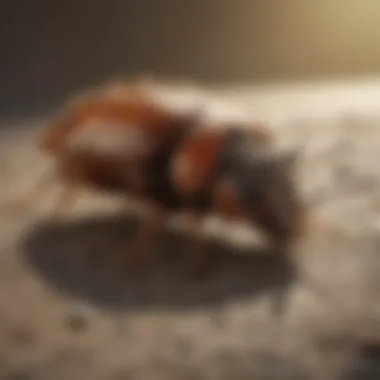Understanding Extermination: Comprehensive Pest Control in Prescott


Intro
In Prescott, pest control is a critical concern for homeowners and businesses alike. Many types of pests, from ants to rodents, pose challenges that require effective extermination methods. This article aims to provide valuable insights into the pest issues in Prescott, focusing on understanding these nuisances, prevention strategies, and control methods. Through a deeper understanding, residents can make informed choices regarding pest control.
Understanding the Pest
Identification
Identifying pests is the first step in combating their invasion. In Prescott, common pests include:
- Cockroaches
- Termites
- Ants
- Wasps
- Rodents
Proper identification helps in choosing the suitable extermination method. Each pest carries its traits and behaviors. For example, cockroaches often thrive in moist areas, while termites require wood for sustenance. Knowledge of these specifics aids in developing a targeted approach.
Life Cycle
Understanding the life cycle of pests can enhance effective control. For instance, the life cycle of a termite includes stages such as egg, nymph, and adult. They multiply quickly, making early eradication crucial. Knowing this cycle allows homeowners to anticipate peak pest activity and time their control efforts accordingly.
Pest Prevention Strategies
Environment Modification
Modifying the environment is a proactive approach to pest prevention. Removing standing water, sealing food containers, and maintaining clean surroundings deter pests from settling. This method does not rely on chemicals, making it safer for families and pets.
Physical Barriers
Implementing physical barriers can prevent pests from entering homes. Simple measures like installing door sweeps, window screens, and sealing cracks can be effective. These barriers stop pests at the outside, reducing the need for extermination later.
Control Methods
Chemical Control
Chemical control remains a common method for pest management. Various products, like those from Orkin or Terminix, are available for specific pests. However, using these chemicals requires careful application to ensure safety for occupants while effectively targeting the pests.
Biological Control
Biological control relies on natural predators to manage pest populations. For instance, releasing ladybugs can control aphid populations in gardens. This method promotes ecological balance but may require professional knowledge for effective implementation.
"Understanding extermination is not just about eliminating pests; it's about developing a comprehensive strategy for prevention and control."
Overview of Extermination Services
Extermination services play a crucial role in maintaining health and safety in residential and commercial spaces. This section explores why understanding these services is important for homeowners and business owners alike. Knowledge about extermination helps make informed decisions when faced with pest issues, thereby ensuring the right action is taken promptly.
Definition of Extermination
Extermination refers to the process of eliminating pests that invade living or working environments. The term often conjures images of toxic chemicals and aggressive tactics, but modern extermination is far more sophisticated. It encompasses various approaches, including chemical, non-chemical, and integrated pest management techniques. Each method aims to eliminate pests effectively while minimizing harm to humans and the environment. Understanding the precise definition allows clients to grasp the methods available and choose the best fit for their specific needs.
Importance of Professional Pest Control
The significance of professional pest control cannot be overstated.
- Health Risks: Many pests carry diseases that pose serious health risks. For instance, rodents can transmit diseases like hantavirus, while certain insects may cause allergies or other health problems.
- Property Damage: Pests can cause considerable damage to properties. Termites, for example, are known to destroy wooden structures, leading to expensive repairs.
- Expertise and Tools: Professionals bring experience and specialized tools that the average homeowner lacks. They can accurately identify pests, assess the severity of infestations, and implement effective treatment plans.
- Long-Term Solutions: Engaging a professional exterminator often results in long-lasting solutions. They provide preventative measures that reduce the likelihood of future infestations.
Professional extermination not only addresses immediate pest issues but also fosters a safer and healthier living environment.
Through this section, readers gain insight into the significance of extermination services and why seeking professional assistance is worth considering. It forms the foundation for understanding the various pest issues that may confront individuals in Prescott.
Common Pests in Prescott


Understanding the types of pests prevalent in Prescott is essential for effective pest control. Each pest poses unique challenges and risks. Knowledge of these pests assists both homeowners and exterminators in developing targeted strategies for prevention and eradication.
Rodents
Rodents are a common sight in many areas, including Prescott. Species such as mice and rats often invade homes in search of food and shelter. They can be a vector for various diseases and cause significant structural damage. Their ability to reproduce rapidly means that a small infestation can quickly escalate into a larger problem if not addressed promptly.
Signs of a rodent infestation include droppings, gnaw marks, and nighttime noises. Preventative measures include sealing entry points and maintaining cleanliness, particularly in food storage areas. Exterminators often utilize traps or bait stations to manage rodent populations effectively.
Insects
Insects are extremely diverse and can range from harmless to extremely harmful. Common insects in Prescott include ants, cockroaches, and bed bugs. These pests can invade homes and create health risks. For example, cockroaches are known to exacerbate allergies and asthma, while bed bugs can lead to discomfort and anxiety among residents.
To identify an insect problem, homeowners should look for bites, droppings, or visible nests. Integrated pest management is a common method to deal with these insects, incorporating preventative measures and treatment options that are less harmful to the environment.
Termites
Termites are particularly concerning for homeowners in Prescott. These pests specifically target wooden structures and can cause extensive damage if left unchecked. Termites feed on cellulose, a component found in wood and other plant materials. A termite infestation may not be immediately visible, making early detection critical.
Signs of termites include mud tubes, discarded wings, and hollowed-out wood. Exterminators often use specialized treatments, such as liquid pesticides or bait systems, to effectively control and eliminate termite populations. Regular inspections are important for early detection and prevention of serious damage.
Wildlife Intrusions
Wildlife can also pose a challenge in Prescott. Animals such as raccoons, squirrels, and foxes may invade residential areas looking for food or shelter. These intrusions can cause physical damage and may introduce disease into the home environment.
Homeowners must be vigilant and observe signs of wildlife activity, like footprints, droppings, or damaged insulation. Professional exterminators utilize humane traps and exclusion methods to safely manage wildlife populations without harm. Additionally, homeowners should secure trash and block potential entry points to reduce wildlife incursions.
Identifying Pest Infestations
Identifying pest infestations is an essential component of effective pest control. Timely and accurate identification allows homeowners to address the problem before it escalates. Ignoring early signs can lead to significant structural damage in a home, not to mention health risks associated with various pests. It is prudent to learn the indicators of infestation. By doing so, homeowners can act swiftly and seek professional help when necessary.
Signs of an Infestation
Identifying the signs of a pest infestation often begins with careful observation. There are several common indicators that can help determine whether pests have invaded your living space:
- Droppings: Finding droppings is usually the first sign of rodents like mice or rats. Their droppings are small and dark in color.
- Gnaw Marks: Check for holes or gnaw marks along walls, cabinets, or furniture, which suggest rodents.
- Nests: Look for nests made of shredded material, such as paper or fabric, often found in hidden corners of the home.
- Unusual Sounds: Paying attention to strange noises during the night can indicate active pests. Sounds such as scratching or scurrying might suggest the presence of rodents or insects.
- Sightings: Seeing a live pest is a clear sign of infestation. Common household pests include cockroaches, ants, and bed bugs.
- Damage to Property: Noticeable damage to your home, such as holes in walls or chewed wires, often hints at more severe infestations, especially from rodents or termites.
Observing these signs early can drastically shorten the response time. Homeowners are advised to conduct regular checks, especially in less frequented areas of their residence.
DIY Identification Techniques
DIY identification techniques can empower homeowners to recognize potential infestations promptly. Here are some effective methods:
- Visual Inspections: Regularly examine both the interior and exterior of the home. Pay special attention to basements, attics, and crawl spaces.
- Monitor Areas Commonly Infested: Bugs often stay in hidden areas, so check behind appliances, under sinks, and along baseboards regularly.
- Traps: Utilize snap traps or sticky traps to catch pests. Their presence, or lack thereof, can provide insight into infestation levels.
- Check for Food Sources: Look for open food containers or crumbs on countertops, as these attract pests. Cleanliness can deter pest infestations.
- Seal Entry Points: Inspect potential entry points like gaps in windows or door frames. Sealing these areas can prevent pests from entering.
By adopting these techniques, homeowners can take a proactive stance in pest management. Early identification can save costs associated with pest control services and promote a healthier living environment.
Early detection is crucial. Knowing how to spot signs of an infestation can save you time and money in the long run.
Methods Employed by Exterminators
Understanding the methods employed by exterminators is crucial for homeowners looking to tackle pest problems effectively. This section delves into various techniques that professionals employ to eliminate and manage pests. Each method has unique attributes, advantages, and considerations. Choosing the right approach is essential to ensure the effectiveness, safety, and long-term results of pest control efforts.
Chemical Treatments
Chemical treatments play a significant role in pest control. Exterminators often rely on pesticides to eliminate infestations quickly. These products can be categorized into contact and systemic insecticides. Contact insecticides kill pests on contact, whereas systemic insecticides are absorbed by plants and affect pests that consume them.
While chemical solutions prove effective, they come with considerations. It is vital to use them responsibly to minimize risks to humans, pets, and the environment. Professional exterminators are trained in safety protocols and application techniques to ensure that treatments do not pose unnecessary hazards. Homeowners should communicate any sensitivities or concerns with their exterminator to tailor the approach.
Non-Chemical Approaches
Non-chemical approaches to pest control are becoming increasingly popular. These methods focus on physical and biological techniques to manage pest populations. For example, traps are a common tool in managing rodent infestations. These are often used to monitor and control the rodent population without using harmful chemicals.


Biological control involves introducing natural predators or parasites to manage pest populations. For instance, ladybugs can be introduced to control aphids.
The benefits of non-chemical approaches include lower risks to non-target organisms, as well as potential cost savings over time. Homeowners who prefer sustainable techniques should discuss these options with their exterminator, ensuring that their pest management strategy aligns with their values.
Integrated Pest Management (IPM)
Integrated Pest Management, or IPM, represents a holistic approach to pest control. This method combines a variety of strategies to prevent and manage pest problems efficiently. IPM emphasizes monitoring pest populations and their impacts before deciding on an appropriate action.
Key components of IPM include:
- Monitoring: Regular inspection to identify pest populations and determine the level of infestation.
- Preventive Measures: Modifying the environment to make it less conducive to pest infestations.
- Control Methods: Employing a range of chemical and non-chemical controls based on monitoring and thresholds.
The IPM method prioritizes sustainable solutions and minimizes risks associated with pest control, making it a preferred choice for many conscientious homeowners. Engaging a pest control service that utilizes IPM can lead to better long-term management of pest problems while maintaining a safe living environment.
Effective pest control requires a comprehensive understanding of methods used by professional exterminators. Homeowners should be proactive and informed when engaging with pest management services.
Eco-Friendly Extermination Options
Eco-friendly extermination options have gained critical importance in the realm of pest control, particularly as consumers become more aware of environmental impacts. The shift towards sustainable practices reflects not only a growing concern for ecosystems but also a desire to protect human health. Homeowners in Prescott, who may seek pest control solutions, will find that using eco-conscious methods can effectively manage infestations without jeopardizing the safety of their families, pets, and surrounding wildlife.
A primary component of eco-friendly pest control involves the use of natural pest control solutions. These alternatives rely on organic substances or biological agents instead of synthetic chemicals. Common methods include:
- Essential oils: Many homeowners may resort to peppermint or tea tree oils to repel rodents and insects. These oils can offer a pleasant scent while deterring pests.
- Diatomaceous earth: This natural powder works effectively against ants, cockroaches, and other insects. When they ingest or come into contact with it, it dehydrates them, leading to their demise.
- Beneficial insects: Introducing ladybugs or lacewings can keep aphids and other harmful insects in check. The presence of these good insects can reduce the need for chemical treatments.
Taking this eco-friendly approach not only serves to contain pests but also harmonizes with nature’s balance. Homeowners should keep in mind that while these methods can be effective, they may sometimes require more patience and follow-up than conventional treatments.
Natural Pest Control Solutions
Natural pest control solutions are essential for those who prioritize an environmentally friendly approach. These solutions tend to focus on prevention as well as management.
- Cultural practices: Keeping a clean yard and home minimizes attractive habitats for pests. Routine practices such as mowing lawns and proper waste management reduce pest appeal.
- Physical barriers: Setting up screens on windows and proper seals around doors can deter insect entry. Small changes, like identifying cracks in foundations and seal them, can prevent rodents from entering.
- Natural repellents: Vinegar, soapy water, or baking soda can repel or eliminate pests effectively and safely.
These steps provide a dual benefit of pest management and maintenance of the household’s ecological health. Homeowners may ask local exterminators in Prescott for further guidance on integrating these solutions into pest prevention strategies.
Benefits of Eco-Conscious Practices
Adopting eco-conscious practices in pest control has several benefits:
- Healthier living environments: Reduced exposure to harmful chemicals lowers health risks for both humans and pets. Many common pesticides contain ingredients that can lead to various health issues, especially in children and pets. An ecosystem that favors natural solutions tends to promote healthier habitats.
- Sustainability: Eco-friendly practices ensure that natural resources are managed responsibly. Preserving biodiversity can be fulfilled through the introduction of natural predators.
- Community awareness: Implementing these practices among Prescott neighbors can foster a community spirit around sustainability. Awareness about pest control can lead to better-informed decisions among residents, encouraging them to opt for more responsible methods.
"Adopting eco-friendly pest control is about creating a safe and sustainable future for all."
Choosing an Extermination Service in Prescott
Selecting an extermination service is essential for maintaining a pest-free environment in your home or business. It can impact not just comfort but also health and structural integrity. Not all extermination services are equal, and understanding what to look for can make a significant difference. Homeowners need to ensure they choose qualified professionals who meet their specific needs.
Qualifications of Professional Exterminators
When hiring an exterminator, checking qualifications is critical. Professional exterminators should have formal training and certifications. Certifications from organizations like the National Pest Management Association (NPMA) demonstrate that the exterminator adheres to industry standards.
Training should include:
- Understanding pest biology and behavior
- Safe and effective application of pesticides
- Knowledge of local pests in Prescott
- Familiarity with eco-friendly practices
Inquire about ongoing education. Technology and methods in pest control are ever-changing. An exterminator who regularly updates their knowledge will likely be more effective.
Questions to Ask Potential Exterminators
Before making a choice, ask the exterminator specific questions to gauge their expertise and reliability. Some pertinent questions include:


- How long have you been in the business?
- What methods do you primarily use for pest control?
- Can you provide references from past clients?
- What guarantees do you offer with your service?
These questions can help you understand the exterminator's approach and ensure they align with your needs. Looking for a good fit is essential.
Insurance and Licensing Requirements
Insurance and licensing are non-negotiable aspects when selecting a service. An exterminator should be licensed to operate in Prescott, which signifies adherence to local regulations. Verify that the company holds liability insurance. This protects you from potential damages during the extermination process.
In summary, choosing the right extermination service involves careful consideration of qualifications, asking the right questions, and checking insurance and licensing. Taking the time to ensure all these factors will help guarantee an effective and safe pest control experience.
Costs of Extermination Services
Understanding the costs associated with extermination services is integral for homeowners and businesses. This section will discuss the various factors that can influence the price of extermination, as well as provide an overview of average pricing in Prescott. This information is crucial, as it equips readers with knowledge to navigate expenses related to pest control effectively.
Factors Influencing Cost
Several factors can contribute to the overall cost of extermination services. Here are some of the most significant ones:
- Type of Pest: Different pests require different methods of treatment. For instance, termite control generally costs more due to the specialized techniques and products involved, while rodent control might be less expensive.
- Severity of Infestation: A minor pest issue can be resolved quickly and cheaply, whereas a severe infestation may need multiple treatments and thus higher costs.
- Size of Property: Larger homes or commercial spaces typically incur higher costs. The area that needs treatment directly influences pricing, as more time and resources are required.
- Treatment Method: Whether a chemical, non-chemical, or eco-friendly approach is chosen will affect the total cost. Each method varies in price, depending on the products and expertise needed.
- Frequency of Service: If a homeowner opts for ongoing pest control treatments, such as quarterly services, this may also impact the overall investment. Long-term contracts might provide savings compared to single treatments.
- Geographic Location: Prices may vary based on regional cost differences for services, which can be particularly true in areas like Prescott, where competition and demand fluctuate.
Average Pricing in Prescott
In Prescott, the average costs for extermination services can vary considerably based on the factors mentioned above. Here is a rough guide to typical pricing:
- Initial Inspection: Many exterminators in Prescott offer a free initial inspection to assess the pest issue. If there is a charge, it typically ranges from $50 to $150.
- One-Time Treatment: The cost can range from $120 to $300, depending on the type of pest and the size of the area being treated.
- Quarterly Service Plans: Regular treatments may cost between $300 and $600 annually. This plan usually includes several visits.
- Specialized Treatments for Termites or Bigger Infestations: Costs for specialized services can exceed $1,000, particularly in severe cases where extensive measures are needed.
Understanding these costs is vital. Being informed enables homeowners to budget effectively for pest control and to choose services that can adequately address their concerns without unexpected expenses.
Preventative Measures Against Pests
Understanding how to prevent pest infestations is crucial for homeowners in Prescott. Proactive measures can save time and money in the long run while ensuring a more comfortable living environment. Effective prevention involves knowledge of common pests, routine maintenance, and an awareness of homeowner responsibilities.
Routine Maintenance Tasks
Regular upkeep of your property plays a significant role in pest prevention. Here are some essential tasks to consider:
- Sealing Entry Points: Inspect your home for cracks and gaps that may allow pests entry. Doors, windows, and vents should be properly sealed.
- Proper Waste Management: Ensure that garbage is contained in sealed bins. Regularly clean outdoor areas to minimize attractants for pests.
- Landscaping Maintenance: Trim overgrown vegetation and ensure trees and shrubs do not touch the house. This reduces pathways for pests to access your home.
- Installing Screens: Use mesh screens on windows and doors to keep insects at bay while allowing fresh air circulation.
Implementing these tasks can create significant barriers against insect and rodent invasions. Regularity is key, thus homeowners should develop a schedule for maintenance tasks.
Homeowner Responsibilities
Homeowners bear a vital responsibility in the ongoing fight against pests. Understanding these responsibilities can ensure effective pest management. Consider the following:
- Awareness of Pests: Be knowledgeable about the types of pests common in Prescott. Familiarize yourself with their signs and behaviors to facilitate early detection.
- Timely Reporting: If you notice signs of pests, address them without delay. Early treatment can prevent more extensive issues.
- Communication with Exterminators: Maintain an open line of communication with your pest control professional. Share any concerns or observed changes in your property that might indicate pest activity.
- Educating Family Members: Ensure that everyone in the household understands pest prevention practices. Everyone should contribute to maintaining a pest-free home.
"Maintaining a pest-free home is a shared responsibility. Everyone needs to play their part."
By adopting proper preventative measures and understanding respective responsibilities, homeowners can substantially reduce the likelihood of pest infestations. This proactive approach is essential not only for comfort but for protecting the integrity of the home itself.
The End
The significance of timely extermination cannot be overstated in pest management. Ignoring a pest problem can lead to a multitude of issues, including property damage and health risks. For homeowners and business owners alike, the immediacy of action is a crucial consideration. Pest infestations often escalate from minor annoyances to severe problems that require extensive and costly remediation.
Importance of Timely Extermination
Timely extermination plays a dual role in pest control: it reduces risks and saves money. When pests are dealt with promptly, the chance of them spreading is minimized. For instance, a few rodents might lead to a full-blown infestation if not addressed quickly. Additionally, many pests, like termites, can inflict hidden structural damage that, if left unchecked, may require hefty repairs.
Homeowners should take signs of pest activity seriously. Early intervention often translates to simpler, more effective treatments. Furthermore, timely response improves a property's hygiene and safety. Pests frequently carry diseases, and their presence in your surroundings can pose serious health concerns, especially to vulnerable individuals such as children or the elderly.
Future of Pest Control Services
The landscape of pest control services is rapidly evolving, driven by advancements in technology and changes in consumer preferences. Sustainability is increasingly prominent, as more homeowners seek eco-friendly solutions. The future may see a rise in the adoption of Integrated Pest Management (IPM), where diverse methods come together to prevent and monitor pests without relying solely on chemicals.
Moreover, the role of technology cannot be understated. Smart traps and sensors that alert homeowners to pest activity are gaining traction. These innovations provide real-time data, allowing for quicker responses and more effective solutions. As consumers prioritize safety and environmental stewardship, extermination companies are likely to adapt their practices accordingly.
In summary, as pest control services continue to integrate advanced technologies and sustainable practices, homeowners can expect more effective and responsible solutions in the market. Staying informed about these trends can assist individuals in making wise decisions regarding pest management.







